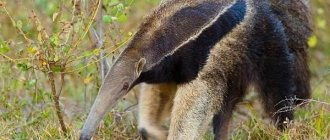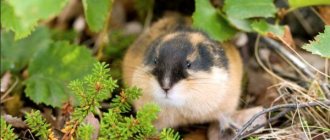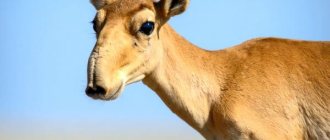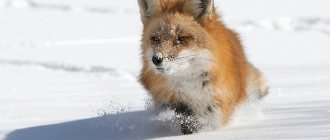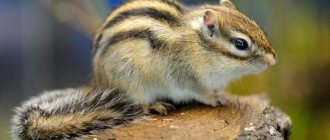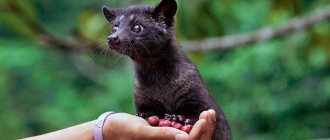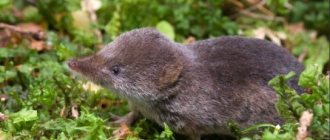- Wild animals
- >>
- Mammals
The sloth is known primarily because of its name. They live in remote South America and are rarely seen in zoos, but few have not heard of these animals with a reputation for being the laziest of all. They are indeed very slow, but not because of laziness, but because they have a very slow metabolism, and the structure of the body simply does not allow them to be fast.
Origin of the species and description
Photo: Sloth
Sloths make up an entire suborder Folivora, which belongs to the order of edentates. Two families have survived to modern times: three-toed sloths or Bradypodidae, described by D. Gray in 1821; two-toed sloths, also known as Megalonychidae, were described by P. Gervais in 1855.
Previously, scientists considered them close relatives - after all, they are very similar in appearance. But then it turned out that this is an example of convergent evolution - although they belong to the same order, they are no more related to each other than anteaters, and their ancestors were very different. The closest ancestors of two-toed sloths were generally gigantic in size and walked on the ground.
Video: Sloth
The oldest edentates appeared in the Cretaceous period and survived the great extinction event that marked its end. After that, they reached their peak: 30-40 million years ago, there were ten times more species of sloths living on the planet than there are now, and the largest of them were the size of an elephant.
Even at that time they lived in South America, and had practically no competition, which allowed more and more new species to appear. But then South America connected with North America - at first this allowed them to expand their range by moving there, but then due to increased competition, many species began to die out.
This process began about 12 million years BC, first affecting the largest of them, then those that were slightly smaller in size - some large sloths even managed to catch humans, as evidenced by marks from tools on their bones and the remains of processed skins. As a result, only the smallest of them managed to survive.
How do sloths communicate?
Although they are loners by nature, the instinct of reproduction still forces sloths to change their secluded lifestyle and go to their soul mate. They rarely see each other, but are very tolerant of their relatives. If there are sloths on the same tree, then there is no place for aggression there. They calmly eat food, they can even sleep next to each other, in general, they are too lazy to even argue. Maybe for this reason they have practically no enemies. These animals also rarely give voice. The three-fingered ones shout: “ah-ah.” And when they are unhappy, they sniffle very loudly. This is how, thanks to the cry, males and females have the opportunity to find each other and continue their race.
Appearance and features
Photo: Sloth in nature
Sizes, like other features, may vary depending on the species, but not excessively. As a rule, their length is 50-60 cm and their weight is 5-6 kg. The body is covered with light brown fur. It often has a green tint due to algae that can grow right in it - this allows sloths to be unnoticeable in the foliage.
The fur is hard and quite long, the head is overgrown with it so much that sometimes you can only see his eyes. Sloths resemble monkeys, however, they are only very distantly related to them; their closest related animals are anteaters.
They have a good sense of smell, but this is the only well-developed sense organ - their hearing and vision are not very sharp. Their teeth do not have roots or enamel, which is why they are classified as incomplete teeth. The skull has two sections, the brain is located in one of them, it is small and has few convolutions.
They are distinguished by the structure of their fingers - they are very tenacious and resemble hooks. This allows them to thrive in trees, giving even monkeys a head start in their ability to climb them - although not in the speed with which they do it.
All sloths have one thing in common that is why they were given their name - slowness. Among all mammals, they are the most leisurely, and they move not just slowly, but very slowly, and in general they try to make a minimum of movements.
G. Fernandez de Oviedo y Valdez, one of the first to compile a detailed description of Central America, described the sloth as the most disgusting and useless creature he had ever seen. However, not everyone will agree with him - many zoo visitors love them very much, as do tourists who get to see them in nature.
Digestive system
Sloths live only in warm environments, as they cannot independently maintain their body temperature. Their lifespan is up to thirty years, and they are ready to reproduce already two years after birth. Analyzing what sloths eat and how they conserve their energy, you are not surprised that with a sedentary lifestyle they live quite well. This is how their stomach works, which has a complex anatomy. It has two departments. Each consists of several chambers. Thus, the digestive system extracts maximum benefits from nutrients for its owners. Considering the low calories from the leaves, this system works at the highest level. It is also interesting that sloths can tolerate hunger quite well. This quality is extremely rare in individuals that eat plant foods.
Where does the sloth live?
Photo: Funny sloth
These animals have a slow metabolism and low body temperature, and therefore they need warmth and they settle only in regions with a warm climate. Their homeland is South and Central America, where they inhabit fairly vast areas. They live alone in dense forests, most often at great distances from each other.
The northernmost country where two-toed sloths live is Nicaragua, and three-toed sloths cannot be found north of Honduras. From these states and to the south they inhabit the rest of Central America, as well as the lands adjacent to the northern coast of Latin America.
The southern borders of the two-toed sloth's range lie in northern Peru. They live in Colombia and Venezuela, in the northern states of Brazil. The range of the three-toed sloth is much wider; it not only includes all the same lands, but also extends much further to the south.
They can be found in Ecuador, throughout Peru, Brazil, Paraguay, Bolivia and Uruguay, as well as northern Argentina. Thus, they live throughout almost the entire territory of South America. Although this does not mean that there are a lot of them: within the range there may be vast spaces in which not a single sloth can be found.
Interesting fact: The only reason sloths have to come down from trees is to defecate. While other arboreal animals do this without descending, sloths always descend to the ground, even though at these moments they are in the greatest danger of being caught by a predator.
In addition, the descent itself takes them a lot of time - a trip there and back can easily take half a day. But they rarely have to empty their bowels, about once a week. After this, they carefully bury their feces in the ground.
Now you know what a sloth eats. Let's see what he eats.
General information
Perhaps these creatures are the most unusual among other representatives of the fauna. The general name of the family of these animals is sloths, and they belong to the edentate species. They are so slow that they cause genuine surprise. It seems that this is impossible, they also have to feed themselves somehow!
Paradoxically, sloths do not need to make much effort to find food. They gorge themselves on leaves so much that two-thirds of their body weight is the weight of a stomach full of food, and then they digest it for a very long time. But these animals are striking not only with their gastronomic preferences (or rather, lack thereof). Sloths hang with their backs down on a tree, and are saved from falling by their claws clinging to the branches.
What does a sloth eat?
Photo: Sloth in America
Their menu includes:
- leaves and flowers of trees;
- fruits;
- insects;
- small reptiles.
They mostly eat leaves, and everything else just supplements their diet. They especially love cecropia - both its leaves and flowers. In captivity it is necessary to give them, because it is not easy to keep sloths in zoos. They prefer to eat young shoots.
They don’t specifically hunt lizards and insects, but if they happen to be nearby and allow themselves to be caught, they can eat them too. This happens infrequently due to the slowness of sloths - usually the prey simply eludes them, so they have to continue chewing the leaves.
The stomach of sloths is complex and adapted to extract all possible nutrients from the food it receives. The rest of their digestive system is also complex, which compensates for the low nutritional value of the leaves. Symbiotic bacteria help sloths with digestion.
Digestion takes a very long time, sometimes weeks. This is not very convenient, because more than 65% of a sloth's body weight can be food digested in its stomach - it is quite difficult to carry it.
But this allows them, if necessary, not to eat for a long time - usually herbivores very quickly begin to starve and lose strength, but this is completely unusual for sloths. In addition, due to their slow metabolism, they are not afraid of the poisons contained in the leaves of some trees in their habitats.
Nutrition
These animals eat very slowly. Where sloths live, there are many tropical trees, so their food is tree leaves, flowers, and occasionally lizards and insects. After a long sleep, the cute lump begins to eat, continuing to hang on the tree. This process, as was said, is very long, so this creature spends its entire life sleeping and chewing food. Food can take up to a whole month to be digested, because the stomach can accommodate food weighing 2 times the weight of the animal! The photo perfectly shows how a sloth hangs on a tree.
The body temperature of these amazing individuals varies in the range of 29-32 °C. But it can easily drop to 24 °C. This rate in mammals is considered very low. In this case, all body processes slow down.
Features of character and lifestyle
Photo: Little sloth
The time of wakefulness differs by species - for example, three-toed sloths are awake and in search of food during the day, but two-toed sloths, on the contrary, sleep most of the day, and only when dusk comes they decide that it is time to refresh themselves. They usually live alone and rarely meet with their relatives due to the fact that they move little.
But if they do meet, they are almost always friendly, they can feed on the same tree and stay nearby for quite a long time - up to weeks. At the same time, they communicate little: they are generally silent, and almost do not change their behavior - as they hung for most of the day almost without moving, they continue to do this, but only together.
They spend more than half the day sleeping, and often hang upside down on a branch. The sloth's movement speed is approximately 3 meters per minute, and on the ground it is even half as fast. When he descends to the ground, his movements become comical - it seems that it is very difficult for him to get around even a very small obstacle.
They also move in trees differently from other animals: for example, a monkey grabs onto branches and holds on using muscle strength. But the sloth has almost no muscles, so it does not hold onto the branch, but hangs on it - its claws are curved like hooks and allow it not to exert force. This saves a lot of energy, but you can only move very slowly this way.
But for the sloth himself this is not a disadvantage, for him such a speed of movement is quite normal, because he does everything else no faster either: for example, he chews food for a very long time, it takes him a lot of time even to simply turn his neck. Fortunately, nature has endowed him with the ability to rotate it 180 degrees.
The sluggish life of a sloth is determined by its biology: it has a very slow metabolism, which means little energy, and a low body temperature - about 30-32 degrees, and during sleep it drops by another 6-8 degrees. Therefore, he has to save on every movement, which his body successfully copes with.
Interesting Facts
This section contains the most unusual and unique facts about sloths. Most of the features of these animals have no analogues in the wild.
Interesting Facts:
- The process of digesting a daily portion can last from one to two months. Complete digestion may take three months.
- Due to the long process of processing food and slow metabolism, sloths relieve themselves once a week.
- Sloths are very clean and never defecate while sitting on a tree. To relieve themselves, animals descend to the ground.
- Sloths have color, but at the same time very poor vision. They practically do not distinguish between objects that are at a distance of 4–7 meters.
- Surprisingly, sloths' closest relatives are anteaters and armadillos.
- Fat reserves for hungry periods are stored in the pads of the hind limbs.
- Sloths' fur grows from their belly to their back.
- Sloths have excellent hearing, so the ears are the main organ of external perception.
- Modern representatives of the species do not exceed 80–90 cm. Extinct relatives could exceed the size of a horse or camel.
- The speed of movement on land does not exceed several meters per minute. In water, sloths can reach speeds of 3 to 4 km/h.
- Sloths, anticipating death, do not descend to the ground. They cling tightly to the tree and continue to be at a height even after death.
- The fur of sloths is thick and long. The structure of hair is porous. Colonies of blue-green algae and fungi settle in the pores, causing the fur to take on a greenish color. This feature enhances camouflage among foliage.
- Some scientists believe that algae and mushrooms serve as an additional source of protein. Sloths regularly lick parasitic colonies from their fur.
- A moth lives in the animal's fur and feeds on blue-green algae.
- Interestingly, sloths not only move slowly. For them, even turning their head or blinking can last for minutes.
- Sloths prefer to do all their business without leaving the tree. This includes sleeping, eating, mating, giving birth and raising babies, and even dying.
- If a baby falls from a branch for some reason, the mother almost never goes down to pick him up.
- Sloths' teeth grow throughout their lives. Because of this feature, they wanted to classify them as rodents, but they changed their minds, since the species has its own unique differences.
- Sloths climb to the treetops and bask in the sun. When it gets too hot, they move into the shade. This behavior is characteristic of cold-blooded animals, not mammals.
Recently, it has become fashionable to keep sloths as pets. To some extent, this is justified, since they are absolutely not aggressive, easily make contact and calmly react to any changes.
But at the same time, keeping sloths in an apartment involves many difficulties. First of all, it is worth noting that animals need a specific diet of eucalyptus leaves. Getting suitable food is quite difficult. Moreover, the volume of daily diet can ruin the owner of an exotic animal.
Social structure and reproduction
Photo: Baby sloth
Usually sloths simply live alone and are encountered only by chance. If a male and female two-toed sloth meet, they can start mating - they do not have a specific season of the year for reproduction, it can occur in any month. For three-toed animals, the situation is different - the season begins in July, when they deliberately search for each other.
Females take care of the offspring, but males have no interest in them, and usually leave the couple long before their birth. At first, the baby hangs on its mother all the time and feeds on her milk, and from the second month it gradually begins to switch to leaves - at first they serve as a supplement, and then gradually occupy an increasing place in the diet.
But, like everything in the life of sloths, this process can take a long time: individuals of some species begin independent life as early as 9 months, but others feed on their mother’s milk for up to two years. And they can literally hang on their mother until the age of 6 months, after which they become too heavy.
The sloth reaches adult size by the age of 3, at which time it becomes sexually mature. They live in nature for up to 10-15 years, in rare cases longer. When kept in captivity in good conditions, a sloth can easily live up to 20-25 years.
Fun Fact: Because sloths don't make sudden movements, they don't need much muscle or a strong heart to pump blood during exercise. Therefore, the heart mass of a sloth is only 0.3% of the body mass, and the muscle mass is 25%. In both of these indicators, he is one and a half to two times inferior to a person who, in turn, is far from a record holder himself.
Reproduction of the sloth animal
The population has a small number of males, so the process of reproduction itself occurs infrequently. Males are polygamous and find a female at the time of mating, and the next season it will be another female. Thus, one male can father more than seven cubs.
The vast majority of sloths breed year-round, except for the three-toed sloth, which does so from mid-summer to early fall.
The gestation period is about six months. Usually there is one newborn weighing about four hundred grams. Childbirth takes place again on a tree, where the female immediately attaches the baby to the nipple.
The baby feeds on mother's milk for four weeks, then gradually expands its diet, but remains a passenger on the mother's back for about another six months. After nine months, the cub leaves its mother for its own territory. Sexual maturity in females occurs at three years, and in males a year or two later.
Natural enemies of sloths
Photo: Sloth on a tree
Among its enemies in nature are:
- jaguars;
- cougars;
- anaconda;
- ocelots;
- crocodiles;
- harpies.
But in reality, most of these predators become a threat to the sloth only when it descends to the ground, and it does this very rarely. This is the secret of the survival of precisely those species of sloths that were small in size when the large ones became extinct - they are able to hang on rather thin branches, where large predators cannot reach them.
Therefore, even jaguars capable of climbing trees can only lick their lips and wait for the sloth to decide to get down from the tree or at least go lower, to the thick branches. But you will have to wait a long time, and sloths are not very tasty due to the almost complete absence of muscles - therefore they are not a priority prey for cats.
In addition, sloths know very well that danger can threaten not only on the ground, but also when descending to the lower branches, and they deliberately climb higher. True, another enemy may meet here - predatory harpies. If a sloth is visible while flying from above, they will certainly attack it, because greenish fur and inactivity play into its hands.
And yet, they also prefer not to climb too high, so it turns out that because of predators, their habitat area in the trees is greatly reduced. These should be fairly thin branches closer to the top, but not the very top, so that the birds cannot see. When there is a flood and the sloths are swimming, crocodiles may try to snack on them.
People are also their enemies: the Indians have hunted sloths since ancient times and ate their meat, lined their saddles with skins, and used their claws for decorations. However, hunting never acquired excessive proportions that would threaten these animals with extinction - after all, they were not a priority prey for people either.
How often do sloths sleep?
Although sloths have a reputation for being lazy creatures, the truth is that in the wild they only sleep about 9 hours a day - about the same as the average person. Sloths like to sleep hanging upside down. This became possible due to the fact that they have long claws that look like hooks. It is difficult to find a sloth sleeping on the ground because it makes it more vulnerable to predators.
My home is my castle
Bradypus tridactylus has a limited habitat. Sloths live in the tropical forests of South and Central America. Previously, scientists believed that animals were found in places where cercopia grows, the leaves of which are the main source of food. Recent studies demonstrate that the number of tree species that act as “homes” for animals reaches about a hundred.
Scientists distinguish two types of these animals:
- Megalonychidae – two-toed;
- Bradypodidae - three-toed.
Representatives of both species are nocturnal. They are practically motionless during daylight hours and incredibly slow at night. A clear confirmation of this is the fact that unicellular green algae manage to grow in animal fur. Initially, the animal's fur has a gray-brown tint. It is the growing algae that gives it its gray-green color. Animal fur is often an ideal hiding place for colonies of fungi and insects such as coprophagous beetles, moths and cockroaches. An interesting point: even the soles of the paws are covered with greenish fur.
The dimensions of the marvelous animals are small: the body length is about half a meter, of which 5 cm is the tail flattened on the sides. The clumsiness of the animals’ torso is compensated by their incredibly mobile neck. Sloths can rotate their necks 270°.
The main occupation of animals is to hang on trees, wrapping their long legs with tenacious claws around the branches. During passive rest, they take a position in which they place all four paws next to each other and bend their back so that their head leans as close to their chest as possible. Long sickle-shaped claws allow the animals to firmly hold onto the branches.
The animals feed mainly on succulent leaves and young branches. They love to eat ripe fruits. Nature has not endowed herbivorous animals with fangs and incisors. The animals' teeth, deprived of enamel, are almost black in color.
Sloths practically do not descend to the ground for the reason that they minimize the likelihood of encountering predators. The animals move on the ground very clumsily. In the event of a meeting with a rival, the animals use their main weapon - sickle-shaped claws. To do this, they roll over onto their backs and grab attackers with tenacious, curved claws.
The only element where sloths show activity is water. Sloths are excellent swimmers, holding their heads high above the water.
This is interesting: How does reproduction occur in insects?
Films and cartoons about sloths
Speaking about these wonderful creatures, one cannot fail to mention their appearance in the “media space”. Animals are often depicted in rather comical ways, which is very popular with the audience and practically does not contradict reality.
So, almost everyone is familiar with the clumsy sloth Sid from the cartoon Ice Age . He is one of the main characters, largely influencing the development of the plot. The most obvious distorted detail is Sid's ability to move across the earth's surface with ease. As we learned earlier, ordinary sloths are incapable of this.
Sid the sloth from the cartoon "Ice Age"
The depiction of mammals in the cartoon Zootopia is considered no less funny. This choice of the filmmakers is a double irony. While they mock sloths, they at the same time compare some office workers with them.
So, in this article we looked at the features of the life of such a beautiful animal as the sloth. It is extremely difficult to observe them in their natural habitat, so we advise you not to miss the opportunity to admire the animals in a zoo or nature reserve.
Where can you find these unique animals and what types of sloths are there?
The habitat of these wonderful animals is the territory of South America, the equatorial and tropical zones. Representatives of the laziest animals on earth are classified into types:
- Two-toed: Hoffmann's sloth, two-toed sloth.
- Three-toed: dwarf, collared, brown-throated, three-toed.
The sizes that sloth animals have are average:
- Body length – up to 60 cm.
- Weight – from 4 to 6 kg.
Animals are classified as mammals. They are somewhat reminiscent of monkeys with long and tenacious limbs. Only their character is different. And also, unlike other mammals, they have 8-9 cervical vertebrae. The head of sloths can easily turn 180 degrees without any difficulty.
Why does the sloth move so slowly?
Sloths come in two-toed or three-toed varieties—two-toed ones are slightly larger. Their diet consists mainly of leaves and is not very nutritious. This is why sloths move so slowly - to conserve energy. When the female is ready to breed, she lets out a cry.
Interesting materials:
Where can you find peace in a zombie farm? Where can you build a house in Skyrim? Where can you hear Nightingale singing and what are its features? Where can you see the Milky Way? Where can I find out the results of a Gia test? Where is the minus on the laptop? Where did Annushka spill the oil on the Patriarchs? Where are the greatest number of altitudinal zones? Where can I find Excel on my laptop? Where can I find Favorites on Avito?
Can sloths live in captivity?
These animals are kept extremely rarely in captivity. The reason for this is their food. From vegetation they prefer mainly cercopia leaves. Sloths eat fruits, small animals such as lizards, or insects less frequently. This usually happens by accident. Therefore, it is difficult to provide this type of mammal with the necessary food. In addition, the three-toed sloth feeds mainly during the day. Two-toed animals prefer the night for food. Sloths' teeth grow continuously. If these animals live in captivity, their life expectancy is significantly reduced – by almost ten years. Thus, they live about twenty years instead of the required thirty years.
As you can see, the sloth is an animal whose description is sometimes amazing. Of course, there are a lot of strange creatures in the world, but this one is truly special. Sometimes you realize how similar it is to a certain type of person. It’s as if this animal was created to remind us of the great human vice - laziness.
